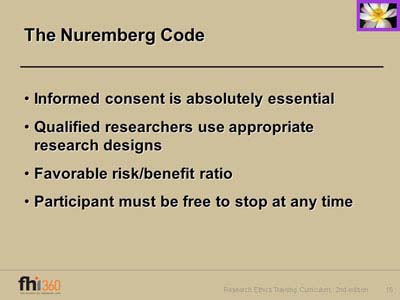
1946 brought with it, dramatic changes in research and human experimentation (Schuklenk, 2005). As a class, we have covered many vital and important issues regarding human welfare and rights, as they relate to ethical research design. Many of these processes are built upon informed consent. However, an animal cannot participate in such a process, and several questions arise; how have we developed guidelines to deal with these dilemmas, and what are their limitations? In the following sections, I would like to explore these important questions to gain a better understanding, and deeper appreciation, of the development and dilemmas within animal-based research.

The Nuremberg Code helped protect human welfare and rights in human-based research (Schuklenk, 2005). However, principles and laws governing animal research have been less stringent and developed (Ferdowsian, 2011). Ferdowsian (2011) also argued that there has been a fundamental and general lack of effort in exploring ethical issues as it relates to animal research, as well as a lack of agreement on what constitutes ethical animal research.

New evidence has also thickened the ethical dilemma in animal experimentation; evidence suggests that animals do experience cognition, pain, pleasure, and a host of other emotions (Ferdowsian, 2011). The dilemma is further deepened by the shared characteristics of vulnerable groups found in human populations; individuals deemed vulnerable (i.e., youths, developmentally challenged individuals) are protected from entering research experiments because of their compromised capacity for self-determination (Ferdowsian, 2011). However, animals that are vulnerable in the same sense, are not protected.

The late nineteenth and twentieth centuries marked significant increases in animal-based research, with no regulations until 1876. It was this period in which the British Parliament passed the Cruelty to Animals Act (Ferdowsian, 2011). Similar acts followed in the United States during the 1960s. However, in both cases, there existed a lack of universal protection of all animals and species; laws protected only some animals and not others (Ferdowsian, 2011). Thus, the importance of the scientific question still overpowered and outweighed the welfare of animals in research, not entirely dissimilar from the ethos of Nazi researchers.
The ethics that govern animal-based research, like human-based research, continues to develop and grow. As in human research, animal research ethics is both a complex and necessary practice; it requires close analysis and ongoing scrutiny, in an effort to improve how we choose to protect a species that cannot speak for itself.
References
Ferdowsian, F. (2011). Human and animal research guidelines: Aligning ethical constructs with new scientific developments. Bioethics, 25(8), 472-478.
Schuklenk, U. (2005). Module one: Introduction to research ethics. Developing World Bioethics, 5(1), 1-13.
-Michael McIsaac
